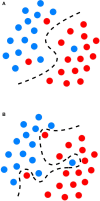Implementing Machine Learning in Interventional Cardiology: The Benefits Are Worth the Trouble
- PMID: 34957230
- PMCID: PMC8692711
- DOI: 10.3389/fcvm.2021.711401
Implementing Machine Learning in Interventional Cardiology: The Benefits Are Worth the Trouble
Abstract
Driven by recent innovations and technological progress, the increasing quality and amount of biomedical data coupled with the advances in computing power allowed for much progress in artificial intelligence (AI) approaches for health and biomedical research. In interventional cardiology, the hope is for AI to provide automated analysis and deeper interpretation of data from electrocardiography, computed tomography, magnetic resonance imaging, and electronic health records, among others. Furthermore, high-performance predictive models supporting decision-making hold the potential to improve safety, diagnostic and prognostic prediction in patients undergoing interventional cardiology procedures. These applications include robotic-assisted percutaneous coronary intervention procedures and automatic assessment of coronary stenosis during diagnostic coronary angiograms. Machine learning (ML) has been used in these innovations that have improved the field of interventional cardiology, and more recently, deep Learning (DL) has emerged as one of the most successful branches of ML in many applications. It remains to be seen if DL approaches will have a major impact on current and future practice. DL-based predictive systems also have several limitations, including lack of interpretability and lack of generalizability due to cohort heterogeneity and low sample sizes. There are also challenges for the clinical implementation of these systems, such as ethical limits and data privacy. This review is intended to bring the attention of health practitioners and interventional cardiologists to the broad and helpful applications of ML and DL algorithms to date in the field. Their implementation challenges in daily practice and future applications in the field of interventional cardiology are also discussed.
Keywords: cardiology; deep learning; interventional cardiology; neural networks; prognosis.
Copyright © 2021 Ben Ali, Pesaranghader, Avram, Overtchouk, Perrin, Laffite, Cartier, Ibrahim, Modine and Hussin.
Conflict of interest statement
RA owns NVIDIA, a company making graphic cards for artificial intelligence analyses, stocks. RA received speaker fees from Novartis Inc. and has a patent pending (R31-07141: METHOD AND SYSTEM FOR ASSESSMENT OF VENTRICULAR EJECTION FRACTION). JH received speaker honoraria from District 3 Innovation Centre and DalCor Pharmaceuticals. The remaining authors declare that the research was conducted in the absence of any commercial or financial relationships that could be construed as a potential conflict of interest.
Figures


References
-
- Overtchouk P, Sudre A, Delhaye C, Juthier F, Van Belle E, Coisne A, et al. . Advanced image processing with fusion and calcification enhancement in transcatheter aortic valve implantation: impact on radiation exposure. Interact CardioVasc Thor Surg. (2018) 27:512–9. 10.1093/icvts/ivy136 - DOI - PubMed
Publication types
LinkOut - more resources
Full Text Sources

